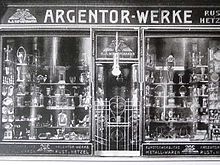Argentor-Werke Rust & Hetzel
| Argentor-Werke Rust & Hetzel | |
|---|---|
| legal form | |
| founding | 1902 |
| resolution | 1970 |
| Seat | Vienna |
| management | Georg Ferdinand Rust, Adolf Wilhelm Hetzel |
| Branch | Manufacturing |
The Argentor-Werke Rust & Hetzel was an important Austrian art professional metal products manufacturer headquartered in Vienna .
history
The company's history goes back to 1863, when C. A. Münchmeyer & Co. was founded. This was the owner of an electroplating factory, which was built in 1894 on a narrow, elongated property between Kaiserstraße and Wimbergergasse in the 7th district of Vienna Neubau . CA Münchmeyer & Co. initially commissioned the Stagl Brodhag company to build a residential and administrative building and, at the same time, a six-storey transverse courtyard wing at Kaiserstraße 83. Branch factories existed in Berlin and Paris at the beginning of the 20th century, with defeats in Vienna in the Casa Piccola at Mariahilfer Strasse 1c in the 6th district and at Waitznergasse 14 in the 4th district of Budapest.
In 1902, the Argentor-Werke Rust & Hetzel emerged from the predecessor company CA Münchmeyer & Co. Over time, the Argentor works became one of the most important manufacturers of metal goods in the Viennese Art Nouveau . Not only silver cutlery , bowls , centerpieces , tea and coffee sets were made , but also home furnishings such as frames , clocks , electric lamps , vases and flower holders . The so-called mounting articles, which were mounted glasses with the frames manufactured by the Argentor works, were of particular importance. A number of the glasses used came from the famous Art Nouveau glass company Joh. Loetz Witwe , with whom Argentor worked.
The company became very successful and had a production volume of thousands of models and worldwide export. A company publication from 1912 mentions around 9,000 items. In 1911 there were branches in Budapest and Brno . Customers included not only the upper class and the aristocracy, but also the imperial court. For their services, the owners Georg Ferdinand Rust and Adolf Wilhelm Hetzel were awarded the title of kuk court purveyor.
The Argentor works survived the First World War despite all the turmoil, but with increasing financial losses. It produced some works during the Second World War , but ceased to exist in 1970 at the latest. Fine works by the Argentor works fetch high prices at auctions today.
Factory building
The Viennese factory was located at Kaiserstraße 83. In 1902 the farm wing in the direction of Wimbergergasse 24 was further expanded. This extension was planned and built by the architect Carl Brodhag and his colleague Ludwig Dillmann . The six-storey building has large glass windows that are spruced up in small pieces. The facade was clad or tiled with white glazed bricks. The narrow parapets of the windows and the attic are made of red clinker . The pillars on the facade end on the roof with an almost classic capital . On the attic, the name "Argentor-Werke" is formed in light blue bricks. The interior is a reinforced concrete construction based on the Hennebique system , which made it possible to enlarge the angle of incidence of light in the windows. The building was one of the first reinforced concrete structures in Vienna. The building is a historical monument. Today there are apartments in the property after several renovations.
literature
- Waltraud Neuwirth: Argentor-Werke Rust & Hetzel, Vienna, Metallwaren-Fabriken, sample book no.13 . Vienna 2006, ISBN 978-3-900282-59-2 .
- Waltraud Neuwirth: Argentor-Werke Rust & Hetzel, Vienna, Metallwaren-Fabriken, sample book No. 30, catalog B: Real bronzes . Vienna 2007, ISBN 978-3-900282-60-8 .
- Art historical working group GeVAG: Viennese facades of the 19th century . Vienna 1976.
- Martin Paul: Technical guide through Vienna . Vienna 1910.
- Manfred Wehdorn, Ute Georgeacopol-Winischhofer: Architectural monuments of technology and industry in Austria . Volume 1. Vienna 1984.
Web links
Individual evidence
- ↑ a b Inge Scheidl: Carl Brodhag. In: Architects Lexicon Vienna 1880-1945. Architekturzentrum Wien, 2006, accessed on June 26, 2011 .
- ↑ Newspaper advertisement around 1900
- ^ Invoice Argentor-Werke 1911
- ^ Court and State Manual of the Austro-Hungarian Monarchy for 1918 . KuK Hof- und Staatsdruckerei, Vienna 1918, p. 563 .
Coordinates: 48 ° 12 ′ 17.7 ″ N , 16 ° 20 ′ 21.4 ″ E


